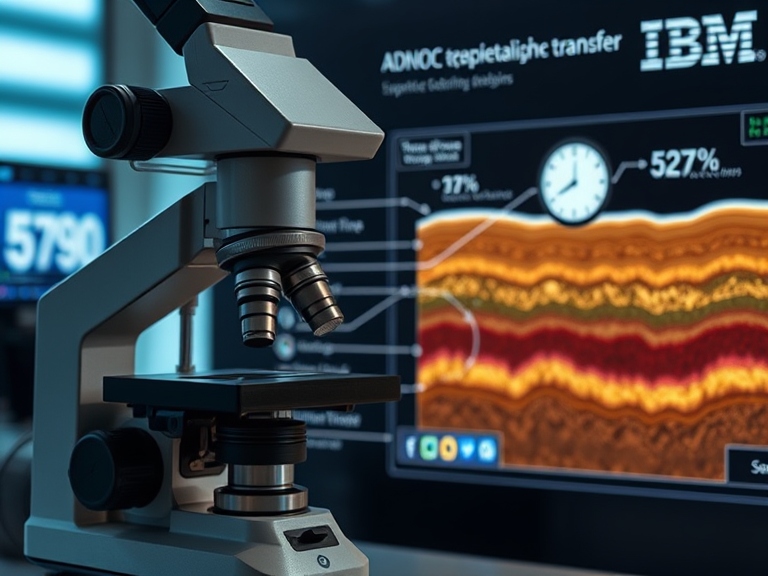Enhancing accuracy, consistency and speed of rock analysis

Project Achtergrond
The foundation of a reservoir simulator’s predictive accuracy — used to guide management’s multibillion-dollar field development decisions — is the fidelity of the geological model. Geology relies on visual microscopic rock descriptions obtained using an optical microscope in a slow, labor-intensive process that has barely changed since the birth of modern geology in 1793. Furthermore, when a petrographer with decades of experience retires, ADNOC loses that person’s accumulated experience. And with so many fast-paced, highly technical careers to choose from, few young people are choosing to become petrographers. For these reasons, ADNOC sought a way to preserve its experts’ experience and enhance the process, possibly within a machine.
Probleemstelling van het project
done For the past several years, IBM has focused on Industry 4.0 initiatives in the oil, gas and petrochemicals industry in the Middle East, leading on digital transformation programs. Partnering with national oil companies in the region is a top priority as IBM works to deliver value through pragmatic partnerships that center on AI, machine learning, the industrial Internet of Things (IoT), cybersecurity and blockchain. At the same time, Hani Nehaid, ADNOC’s Geoscience Team Leader, and his team were considering using AI to augment and accelerate the thin section description process. So when Nehaid, along with Douglas Boyd, Technical Center Petrophysicist and Hesham Shebl, Technical Center Geologist (Petrographer), encountered an IBM representative at an industry dinner, the potential of utilizing AI and Watson solutions to address this challenge with visual recognition technology became a subject of mutual interest. Boyd explains: “We had a short discussion with the IBM rep about how we could pursue this aspiration. We started by working together with their data scientists to repeatedly train the platform. Then we prepared a small sample set for them to analyze as a proof of concept. This delivered very accurate results, equivalent to our most experienced petrographer. We were very impressed, and we moved ahead from there.”
Technologische innovaties
AI
Doelstelling van het project
ADNOC’s use of AI to augment geological research has already been successful. Though drilling and scanning rock samples must remain manual processes, image classification is now much faster and more automated. Because Watson can analyze 527 images per second, analyzing all of the samples taken from a single reservoir now takes only minutes – not months. Beyond the increase in classification speed, Nehaid and his team are already experiencing several other key advantages of the AI-driven Watson solution. With analysis time reduced significantly, ADNOC can evaluate many more rock samples from many more wells, generating more deterministic data. This, in turn, leads to more accurate and effective subsurface models. The solution also improves consistency. Says Nehaid: “Two different geologists with different levels of experience will provide different levels of accuracy in their rock descriptions. With IBM Watson, we are ensuring that the description and interpretation is always at the expert level and that it will remain consistent throughout the years.” He continues: “These factors are enhancing our subsurface models, which in turn significantly de-risk and support better investment decisions in multibillion-dollar field developments.” IBM Watson’s AI libraries provide ADNOC with a way to preserve its petrographers’ decades of experience without having to undergo the years-long process of bringing new experts up to speed. Says Nehaid: “The solution lets us free up our geologists’ time to focus on model generation, as well as transfer our experts’ knowledge and experience to the machine so we can take advantage of their experience after they move on.” Nehaid and his team are optimistic about the future of the project. Says Shebl: “Ultimately, I see machine learning assisting the entire process of creating representative geological models and helping us create a clear understanding of the subsurface. Cutting-edge technology and innovation partnerships are allowing us to create development plans that help us achieve our strategic goals: to increase recovery at the end of a field’s life to 70%, and ultimately to help create a more profitable ADNOC upstream.” IBM, too, is encouraged by the success of the ADNOC engagement. Talal Malas, Cognitive and Analytics Practice Leader with IBM Middle East and Africa, explains: “We believe that AI is a partnership between man and machine. This initiative with ADNOC is one of the most exciting use cases in the chemicals and petroleum industry — cognitive geology, which emulates geologists and petrophysicists in classifying rock samples with high accuracy at an enormous scale. It's the perfect example of how AI boosts productivity and frees up highly skilled experts for higher value activities.” Yahya Mahmoud, Industry Leader for Industrial Products and Chemicals and Petroleum Industry for IBM Middle East and Africa, adds: ”At IBM we believe in innovation that matters, for our company and for the world. We dare to create original ideas with focus and dedication to our clients' success. The partnership between ADNOC and IBM brought these values to life. The entire value chain builds up from the geosciences, it was intuitive to start there. We share ADNOC's aspiration of further developing the solution to tap into more data points from the subsurface to enhance hydrocarbon recovery.”
Technology Providers
IBM